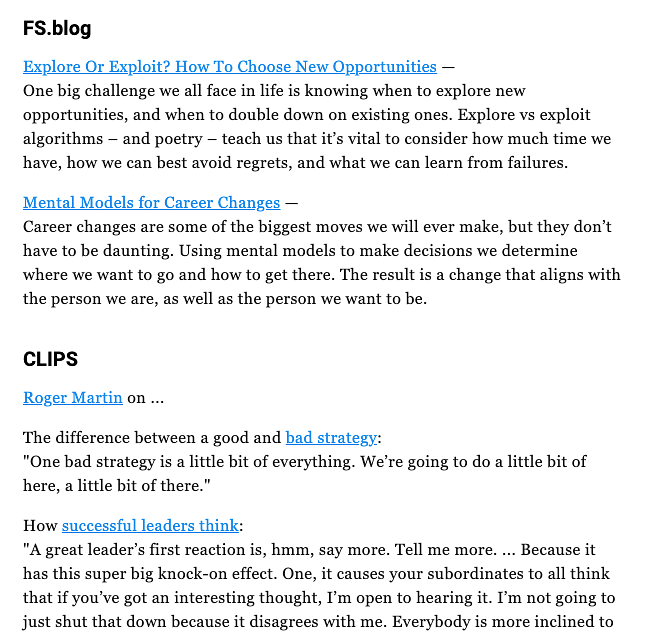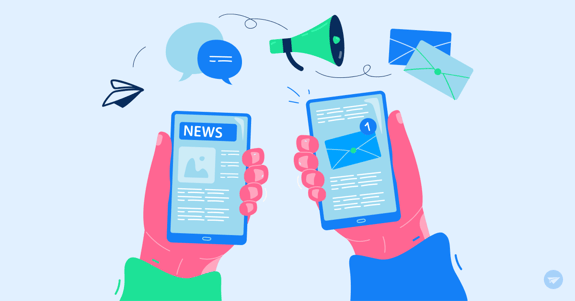There are many social media platforms these days and the number of people on these social media platforms is also growing. But their attention span is decreasing. The content is increasing and thus you end up fighting for a few seconds of attention, your content gets lost and you don't even 'own' the audience.
So how can you get direct access to the inbox & undivided attention of your audience while creating content that drives value for them?
The answer is through newsletters.
Table of Contents
- What is an Email Newsletter?
- What is the Purpose of a Newsletter?
- How To Measure The Success Of Your Email Newsletter?
- Importance Of Newsletters?
- How to Create an Email Newsletter Subscribers Want to Read (with tips, examples, and design ideas)
- What Is a Good Average Open Rate for Email Newsletters?
- FAQs
What is an Email Newsletter?
An newsletter is a periodical email sent by a person or business containing news, updates, curated content from the topic that you signed up for.
Unlike an automated abandon cart email, upsell email that almost hypnotizes you to ‘buy', ‘join’, or ‘enroll’, a newsletter focuses on delivering free, valuable content.
What is the Purpose of a Newsletter?
There are two main purposes of a newsletter:
1.Share information: Use a newsletter to give customers updates about your company and how your product is progressing to help make your customer's lives better. This is a great way to stay in touch with your audience and not be forgotten.
2. Brand marketing: Provide valuable content to your audience so they look forward to your emails and also build a brand recall.
3. Building trust: When you deliver content that is relevant to your customers and can help them do their job better or live their life to the fullest, they will get in the habit of opening your emails. So when you send them a promotional email, they are less likely to ignore you.
Newsletters can also be used to promote your products and services but do a hard sell. You can weave the offer in your story or content, put it in the PS section or you can dedicate a small section in every newsletter that is reserved for promotion.
How To Measure The Success Of Your Email Newsletter?
The best thing about email marketing is that you can judge whether your content, messaging, emails are working on what is concrete data instead of making assumptions.
To measure the success of your newsletter, look at two categories of KPIs - List Health & Email Performance.
Email Performance
- Open Rate: It is the percentage of people who opened your email. This is a key metric to show engagement.
How Email Open Rate is calculated: (total unique opens ÷ total recipients) x 100
A low email open rate means two things:
- Either your emails are not getting delivered to the inbox and are going to the spam box instead.
- Or your subject lines are not exciting enough for people to open your emails.
- Click to Open Rate: The percentage of people who clicked on the CTA given in the email.
How Click to Open Rate is calculated: (unique clicks ÷ unique opens) x 100
This shows the effectiveness of your newsletter content and CTA (whether it made the reader take an action or not). Usually, it's a good practice to make your CTA clear and repeat it more than once to increase the click-to-open rate.
List Health
- List growth rate: The rate at which the total number of subscribers in your broadcast list increases. It is calculated after taking into account new subscribers and subtracting the unsubscribers.
([(Number of new subscribers) - (Number of unsubscribes + email/spam complaints)] ÷ Total number of emails on your list]) x 100
If your list is growing that means enough people are hearing about it on social media platforms, through friends, and are joining your email list.
- Unsubscribe Rate: Percentage of people who opted out of your email list after receiving an email.
(Unsubscribers ÷ Successful email deliveries) x 100
If you have a high unsubscribe rate that means your newsletter seems interesting and relevant but once people receive it, they might not be getting much value.
Make sure that your list is growing, fewer people are unsubscribing and your open rate doesn't go down a lot when your subscribers increase.
Importance Of Newsletters?
Newsletters are not just pieces of 'free' content that you send out to sound generous or 'lure' your customers to buy from you. And you shouldn't create a newsletter just because other brands are creating those.
You will be able to better utilize newsletters to grow your business and brand value if you understand their importance. To make the most of a newsletter, you need a reliable internet connection.
Newsletters are important because they help you:
1) Build brand authority: When you send a newsletter on a topic that is relevant to your audience, they see you as an expert in that field. That builds your authority and increases the chances of you getting the customer's business vs someone who doesn't send a newsletter.
2) Keep your customers engaged: If someone has bought a product from you & will likely not buy anything else for the coming few weeks (e.g. an online course of a basket of snacks), how do you keep them interested in your brand? The answer is through the digital newsletter. Send some helpful information, how-to-guides, or tips to deliver beyond what is expected and engaged with your brand.
How to Create an Email Newsletter Subscribers Want to Read (with tips, examples, and design ideas)
Everyone at SendX loves newsletters and we get hundreds of them every day ( I get thousands maybe ;p).
So I decided to ask my teammates about what characteristics do they like in newsletters that make them want to read those. So here's your list of what to do if you want to create an email newsletter subscribers wouldn't want to unsubscribe from:
1.Engaging subject line: A humorous, curiosity-driven, or personalized subject line is more attractive than a boring, lengthy string of words that get lost in your inbox.
Here are some subject line examples from my inbox that made me open these emails. Identify what's interesting about each one and take a mental note for your subject lines.

2. Consistent schedule: Deliver your emails as per the cadence you promised your subscribers. Keep a consistent schedule so people don't miss out on your emails.
3. Focus on content: Your content should either educate, entertain or inform. If it is something you won't find relevant perhaps your audience will also not. So find out what your audience actually wants to read and deliver the best content related to that.
Here's an example from fs.blog that delivers valuable content and links to read more in each newsletter.

4. Mobile friendly: Most people read emails while having coffee, waiting for food to arrive, or before they go to bed. And at all these times, emails are read on mobile. So make your emails responsive on mobile and other reading-friendly devices such as tablets or iPad.
5. Readable font: Newsletters can have visual elements like infographics and images but you will still have to set some context with the help of words. So choose a font that is readable, even on mobile.

What Is a Good Average Open Rate for Email Newsletters?
The average open rate for newsletters varies from one industry to the other. As per a report by Influencer Marketing Hub the average open rate across industries is 17%.
Average open rate for B2C emails is 21.9% & 20.8% for B2B emails.
But my suggestion would be to not pay much attention to these. No two newsletters, audiences, brands are the same so why compare your email open rates to generic numbers.
The best way to determine a good benchmark for email open rates for your business is to track the open rate of an email newsletter for a month or quarter. Then average them to get your benchmark which will help you analyze whether your open rate needs attention or not.
FAQs
1) What is an email newsletter used for?
An email newsletter is a periodical email sent by a person or business containing news, updates, or curated content from the topic that you signed up for.
2) Why is a newsletter important for a content marketing strategy?
As your newsletter produces quality content about a topic or area that you have expertise in, your business will become a reference as a source of information about that topic. And by creating a newsletter publishing routine, you promote customer loyalty, and gain the trust and respect in the eyes of your audience.
3) What goes into making a successful newsletter?
For a newsletter to be truly effective, you need to tick certain boxes, like:
- Offering value for time spent on reading it
- Leverage new content (or even evergreen content)
- Engaging subject line
- Personalized and consistent content
- Consistency of quality
4) Which type of newsletter is better? Crafted or curated newsletter.
It depends. For example, from a traffic perspective, a crafted newsletter is better because it sends traffic to your own website or blog, whereas a curated newsletter mostly shares links from outside sources and sends traffic to them.


